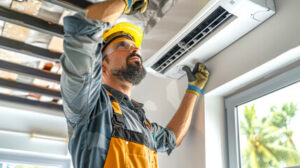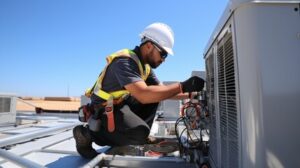Air Conditioning Installation Naples FL is a significant investment in your home. Hiring a professional is essential to ensure a quality install and avoid costly mistakes that can impact system efficiency and void warranties.

The installation process starts with an in-home estimate. The contractor will perform a manual j load calculation to find the right size air conditioner for your home.
Installing a new air conditioning system can be a significant investment, but it is one that adds measurable value to your home or business and improves overall comfort. The cost of an AC installation depends on several factors, including the unit size and SEER rating, brand, and labor costs. It is important to compare quotes from multiple contractors before selecting a company. Look for manufacturer rebates, tax credits, and local utility incentives to reduce your overall costs.
The average cost of a new air conditioner is $5,000, but this can vary depending on several factors. Some of the most common include the size of the unit, ductwork installation, and electrical upgrades. It is also important to factor in the annual maintenance costs and energy costs, which will impact your monthly bills.
Before the technician starts work, they will visit the space where the AC will be installed and take measurements. They will also assess the existing ductwork and any other requirements for the installation. Then they will remove any old equipment or ductwork, and install the new unit according to the manufacturer’s instructions. They will then test the unit to make sure it is working correctly, and they will clean up any mess.
During the installation process, the contractor will need to do some electrical work in order to connect the system to your home’s power grid. This may include running new wiring and installing a thermostat. It is best to hire a professional to perform this work, as errors can lead to inefficient operation and voided warranties.
A good place to start when estimating the cost of an air conditioner is to get multiple quotes from different contractors. This will help you find the best deal and avoid overpaying for your new system. You should also consider the price of a new AC unit with a higher SEER rating, as this will save you money in the long run.
You can choose between a central AC system and a ductless mini-split system, depending on your needs and budget. A ductless system is ideal for homes without existing ductwork, and it is less expensive than a central AC system. However, it is not as effective as a central AC system in cooling large spaces.
Installation requirements
A well-functioning air conditioning system can enhance your quality of life and improve your home’s market value. However, it is important to follow proper installation procedures and have a qualified technician perform the work. A poorly installed AC can increase energy consumption, reduce efficiency, and cause damage to your home’s interior and structure. Moreover, improper electrical connections can lead to a fire hazard and can also damage your air conditioner.
The first step in installing an air conditioning system is preparing the area where it will be placed. This includes clearing away furniture, decorations, and other items that could get in the way of the installers. It is important to leave the area clear so that the technicians can move around without causing any damage or interference to your home.
After removing any existing air conditioning equipment, the installers will set up the new units. They will mount the indoor unit high on a wall and secure it with mounting brackets. They will also ensure that the unit is properly insulated and connected with refrigerant lines. In addition, they will connect the unit to the thermostat using a refrigerant line and check for leaks.
Air ducts are also important to a good air conditioning system. The air conditioner will produce a lot of condensation, which needs to be drained away. The installers will establish a drainage route that prevents water damage and maintains indoor air quality. They will also inspect the ductwork and make necessary repairs if needed.
Before the air conditioning installation, it is important to have an Equipment Use Permit (EUP). This document proves that your cooling system meets all building code requirements and will help you avoid any legal issues. This document is required for commercial or residential properties that have a cooling system. You can obtain an EUP by filing a plan with the city or getting a permit from an inspection agency. Once the permit is issued, you can start the air conditioning installation process. A skilled air conditioning service will test the system and provide a walk-through on how to operate it.
Warranty
Many homeowners are unaware that their new air conditioning system comes with a warranty. Some manufacturers offer a basic limited warranty on the equipment, while others offer extended warranties on specific parts of the system. Depending on the unit, these warranties can last up to 20 years. To avoid voiding your warranty, be sure to register your unit within the required timeframe. It’s also important to keep records of maintenance visits, as these may be critical for maintaining your warranty coverage.
The type of installation of your air conditioning system can impact its warranty coverage. Some manufacturers offer longer warranties if the system is installed by certified technicians. Other factors include the model and brand of your unit. These can influence the cost of the installation, as well as potential repair costs. If you have questions about the air conditioning installation process, it is best to consult a professional to discuss your options.
Most manufacturers have online portals where you can verify your air conditioner’s warranty coverage. You can also look up the serial number of your unit to determine whether it has been registered. If you haven’t registered your unit, contact the manufacturer directly to find out more information about the warranty terms and conditions.
Air conditioning warranty terms vary by manufacturer, but most include coverage for replacement parts and labor costs associated with installation. In addition, some warranties can be transferred to a new homeowner upon sale of the home. However, the warranty terms and conditions vary, so be sure to review the contract before transferring ownership.
Many HVAC systems also come with a labor warranty that covers installation errors and workmanship. However, these warranties typically do not cover normal wear and tear. To ensure that your warranty remains valid, you should make sure to have the installation work done by a qualified professional and keep records of service and maintenance.
A warranty for a new HVAC system is important, as it will protect the investment you have made in your home. It will help you avoid costly repairs in the future. Most manufacturers will provide a warranty for up to 20 years, with some offering an additional 5-year warranty on the compressor.
